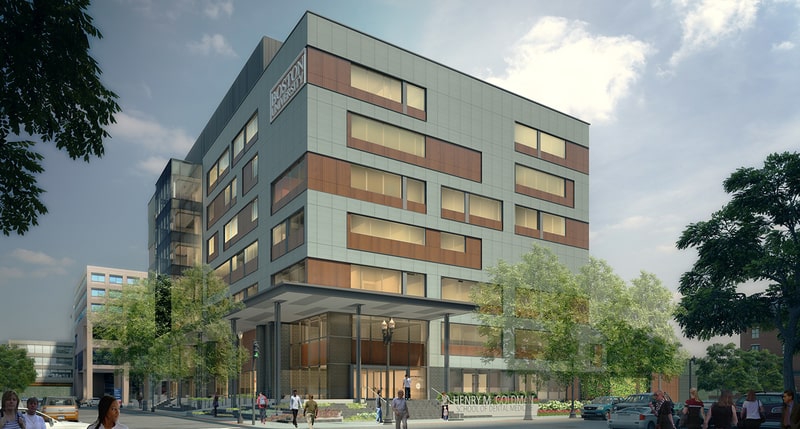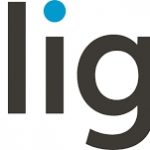
Boston University Henry M. Goldman School of Dental Medicine this week celebrated the completion of a $115 million, three-year construction project that transformed its existing facility, increasing the building’s size by about 48,000 square feet and expanding clinical spaces by 70 percent.
Two additions were constructed – a seven-story addition on the building’s west side and a two-story addition on the north side – and about 63,000 square feet of existing space was renovated in order to achieve the project’s primary goals: to expand and improve predoctoral clinical spaces, to integrate the school’s preclinical Simulation Learning Center (SLC) into the Albany Street facility, and to support student collaboration and peer-to-peer learning through the creation of a variety of student-focused common areas. The project was designed by SmithGroup, an integrated design firm with a network of 15 offices in the U.S. and China.
“Here at GSDM, we believe we must be ahead of the industry as a whole in order to ensure that we are educating students who will be leading practitioners in the digital dentistry era,” said Dean ad interim Cataldo Leone. “The completion of this transformative project ensures that we have the facilities we need to deliver on that mission.”
The project added 28 chairs to the school’s expanded and renovated predoctoral Patient Treatment Center, for a total of 100 dental chairs split over three floors and five distinct spaces, all outfitted with state-of-the-art dental technology. The Patient Treatment Center also includes cutting-edge laboratories with digital radiography with two-dimensional and three-dimensional imaging and robust five-axis milling units; the school has also incorporated 3D printing at a large scale into its treatment center.
The improvement and expansion of the school’s clinical facility ensures that it will be able to provide its patients – patients who often are among the most underserved populations in Boston – with the best oral healthcare possible while incorporating these advanced technologies into its clinical curriculum, maintain the school’s position as a global leader in dental education.
“The importance of the renovations and expansions to the school’s Patient Treatment Center cannot be overstated,” said Leone. “The school’s clinical facility is where our predoctoral students apply what they have learned in their didactic and preclinical courses to actual patient care – it is where they truly learn to be oral healthcare providers – and thus is a critical component of our dental school’s curriculum.”
The construction project also allowed the school to integrate its Simulation Learning Center into its main facility at 635 Albany Street. The new 117-station center, which also includes two teacher stations, is outfitted with state-of-the-art technology, including simulators, intraoral scanners, ultrasonic scalers, electric handpieces, curing units for composite restorations, and a high-speed evacuation system. These technologies match what students will use once they enter the Patient Treatment Center, ensuring that students’ preclinical education is a true simulation of what they will encounter in the clinical portion of their experience.
The new SLC replaced the school’s existing simulation center, which first opened in September 2000 and was located across the street from the dental school at 650 Albany Street. Integrating the SLC into the school’s primary facility will better support the continuum of student learning and strengthen the connections between the didactic, preclinical, and clinical portions of students’ education.
Finally, as part of the construction project, numerous student-centered collaborative and learning spaces were built throughout the building, including a Student & Resident Lounge on the first floor and a flexible, 140-seat lecture hall, which provides a venue for the school’s larger classes, as well as events and symposia. These spaces, which did not exist in the original dental school facility, provide opportunities for students to gather with their peers to study, socialize, and learn from each other through informal interactions. The collaborative spaces will improve dramatically the student experience at GSDM and will strengthen the fabric of the school community. A new academic entrance on East Newton Street leads to student collaborative space for informal learning and social gathering.
In addition to these primary goals, the project also transformed the exterior of the existing facility at 635 Albany Street: the existing mid-century building, constructed in 1970 and first expanded in 1973, was re-clad with a modern façade, bringing the look of the facility into the 21st century and aligning the building’s look with the school’s innovative and cutting-edge reputation.
Planning for this project first began in 2010, and the school broke ground for the project’s first phase in 2018. The project was structured into four separate phases, which allowed the dental school to continue all its educational and patient care operations uninterrupted. This extensive phased planning also allowed for flexibility, which helped when the school needed to adjust construction logistics to adapt to COVID-19 safety protocols. That flexibility enabled the team to reprioritize construction activity after the City of Boston-mandated moratorium to help the school meet milestones in their semester schedule while keeping the project on track for a July 2021 completion.
SmithGroup’s Detroit and Boston offices provided integrated design services including master planning, architecture, interior architecture, building enclosure consulting, mechanical, electrical and plumbing (MEP) engineering, structural engineering, lighting design, and landscape architecture. Shawmut Design and Construction (Boston) served as the general contractor and Compass Project Management, Inc. (Norwood, Mass.) as the owner’s project manager. Other key design team members include Nitsch Engineering (Boston) providing civil engineering.
ABOUT BOSTON UNIVERSITY HENRY M. GOLDMAN SCHOOL OF DENTAL MEDICINE
Boston University Henry M. Goldman School of Dental Medicine (www.bu.edu/dental) is a premier academic dental institution promoting excellence in dental education, research, oral healthcare, and community service to improve the overall health of the global population. With a faculty of more than 325 educators, clinicians, and researchers and more than 250 staff members, the school, which was founded in 1963, offers a full spectrum of predoctoral and postdoctoral education programs and a complete range of graduate programs and degrees to more than 800 students. The school has more than 8,000 alumni who live and practice around the world.
RELATED ARTICLES
Dugoni School of Dentistry Introduces The Pacific Center for Equity in Oral Health Care
Kerr Celebrates 130 Years of Dental Innovation
Delta Dental Institute Funds New Oral Health Research From Leading Academic Institutions
EXIT SURVEY
Have you been to DentistryToday.com before?
Do you have any input? Anything you’d like to see covered here?
Contact the digital content editor at jfinnegan@dentistrytoday.com with your notes.











